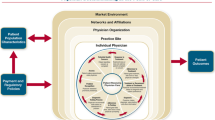Abstract
OBJECTIVE: To develop a sound method to identify patient and physician characteristics that influence specialty referrals.
DESIGN: A retrospective cohort analysis of medical claims data from 1996 supplemented with surveys of primary care physicians.
SETTING: A 600-member independent practice association in southeastern Michigan that provided care for 90,000 members of an HMO.
PATIENTS: Five cohorts, each of 2,000 to 6,000 patients with diagnoses that could be referred to cardiologists, ophthalmologists, pulmonologists, orthopedists, or general surgeons.
MAIN RESULTS: The referral rates for the different cohorts ranged from 1% to 7%. The discriminatory ability of the multivariate logistic models (c-statistic) ranged from 0.66 to 0.79. The likelihood of referral was associated with the patient’s diagnoses and medications and with the referring physician’s age, years out of medical school, satisfaction with the specialty being referred to, and the importance of making or confirming a diagnosis.
CONCLUSIONS: Because these methods were not difficult to implement and the results were credible, we believe that other organizations should be able to use them.
Similar content being viewed by others
References
Kerr EA, Mittman BS, Hays RD, Siu AL, Leake B, Brook RH. Managed care and capitation in California: how do physicians at financial risk control their own utilization? Ann Intern Med. 1995;123:500–4.
Eisenberg JM. The internist as gatekeeper. Ann Intern Med. 1985;102:537–43.
Wilkin D, Smith A. Explaining variation in general practitioner referrals to hospitals. Fam Pract. 1987;4:160–9.
Lasker RD, Shapiro DW, Tucker AM. Realizing the potential of practice pattern profiling. Inquiry. 1992;29:287–97.
Warren BH. An outcomes analysis approach to utilization management: quality assessment of appropriateness of specialty referrals. Utilization Management. 1994;9:34–8.
Cochrane RA, Singhal H, Monypenny IJ, Webster DJT, Lyons K, Mansel RE. Evaluation of general practitioner referrals to a specialist breast clinic according to the UK national guidelines. Eur J Surg Oncol. 1997;23:198–201.
Nutting PA, Franks P, Clancy CM. Referral and consultation in primary care: do we understand what we’re doing? J Fam Pract. 1992;35:21–3.
Franks P, Clancy C. Referrals of adult patients from primary care: demographic disparities and their relationship to HMO insurance. J Fam Pract. 1997;45:47–53.
Salem-Schatz S, Moore G, Rucker M, Pearson SD. The case for case-mix ajustment in practice profiling. JAMA. 1994;272:871–4.
Weiner JP, Starfield BH, Steinwachs DM, Mumford LM. Development and application of a population-oriented measure of ambulatory care case-mix. Med Care. 1991;29:452–72.
Welch HG, Black WC, Fisher ES. Case-mix adjustment: making bad apples look good. JAMA. 1995;273:772–3. Comment.
Verrilli D, Welch HG. The impact of diagnostic testing on therapeutic interventions. JAMA. 1996;275:1189–91.
Langley GR, Minkin S, Till JE. Regional variation in nonmedical factors affecting family physicians’ decisions about referral for consultation. Can Med Assoc J. 1997;157:265–72.
Roland M, Morris R. Are referrals by general practitioners influenced by the availability of consultants? BMJ. 1988;297:599–600.
Webb S, Lloyd M. Prescribing and referral in general practice: a study of patients’ expectations and doctors’ actions. Br J Gen Pract. 1994;44:165–9.
Langley GR, MacLellan AM, Sutherland HJ, Till JE. Effect of non-medical factors on family physicians decisions about referral for consultation. Can Med Assoc J. 1992;147:659–66.
Grol R, Whitfield M, De Maeseneer J, Mokkink H. Attitudes to risk taking in medical decision making among British, Dutch and Belgian general practitioners. Br J Gen Pract. 1990;40:134–6.
Langley GR, Tritchler DL, Llewellyn-Thomas HA, Till JE. Use of written cases to study factors associated with regional variations in referral rates. J Clin Epidemiol. 1991;44:391–402.
Calman NS, Hyman RB, Licht W. Variability in consultation rates and practitioner level of diagnostic certainty. J Fam Pract. 1992;35:31–8.
Coulter A, Noone A, Goldacre M. General practitioners’ referrals to specialist outpatient clinics. BMJ. 1989;299:304–8.
Hanchak NA, Schlackman N, Harmon-Weiss S. US Healthcare’s quality-based compensation model. Health Care Finance Rev. 1996;17:143–59.
McArdle PJ, Whitnall M. The referral practice of general medical practitioners to the surgical specialties: implications for the future. Br J Oral Maxillofac Surg. 1996;34:394–9.
Elixhauser A, Andrews RM, Fox S. Clinical Classifications for Health Policy Research: Discharge Statistics by Principal Diagnosis and Procedure, Division of Provider Studies Research Note 17, Agency for Health Policy and Research. Rockville, Md: Public Health Service; 1993. AHCPR publication 93-0043.
Elixhauser A. Clinical Classifications for Health Policy Research, Version 2: Software and User’s Guide. Healthcare Cost and Utilization Project (HCUP-3), Research Note 2. Rockville,
Cowen ME, Dusseau DJ, Toth BG, Guisinger C, Zodet MW, Shyr Y. Case mix adjustment of managed care claims data using the Clinical Classification for Health Policy Research (CCHPR) method. Med Care. 1998;36:1108–13.
McEvoy GK. AHFS 97 Drug Information. Bethesda, Md: American Society of Health-System Pharmacists; 1997.
Harrell FE Jr, Califf RM, Pryor DB, Lee KL, Rosati RA. Evaluating the yield of medical tests. JAMA. 1982;247:2543–6.
Harrell FE Jr, Lee KL, Matchar DB, Reichert TA. Regression models for prognostic prediction: advantages, problems, and suggested solutions. Cancer Treat Rep. 1985;69:1071–7.
Jollis JG, Ancukiewicz M, DeLong ER, Pryor DB, Muhlbaier LH, Mark DB. Discordance of databases designed for claims payment versus clinical information systems. Ann Intern Med. 1993;119:844–50.
Author information
Authors and Affiliations
Rights and permissions
About this article
Cite this article
Cowen, M.E., Zodet, M.W. Methods for analyzing referral patterns. J GEN INTERN MED 14, 474–480 (1999). https://doi.org/10.1046/j.1525-1497.1999.06368.x
Issue Date:
DOI: https://doi.org/10.1046/j.1525-1497.1999.06368.x




